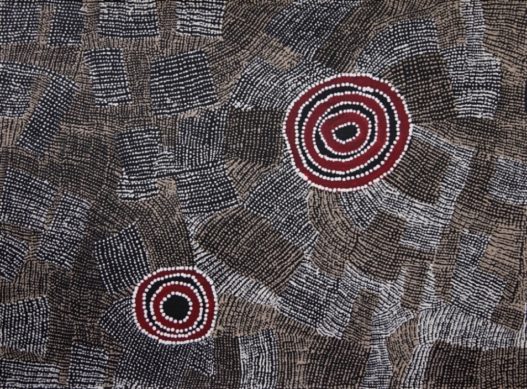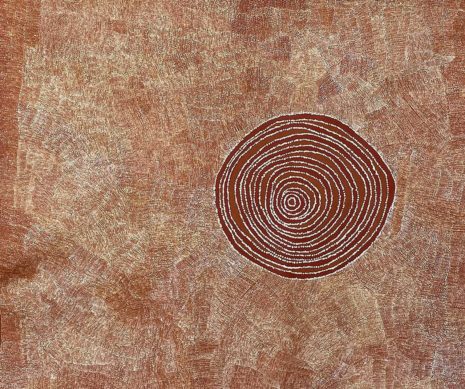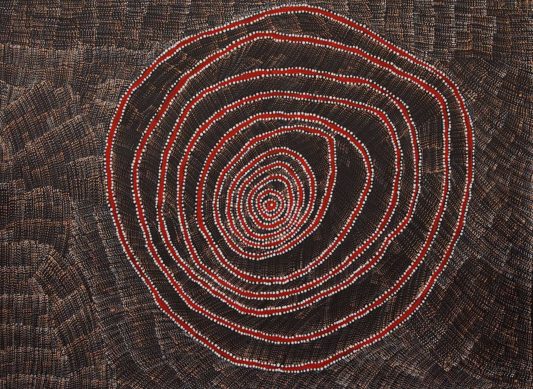Wentja Napaltjarri
Wentja Napaltjarri, b. 1945, senior Pintupi artist & daughter of Shorty Lungkata, paints ancestral country.
Pintupi artist Wentja Napaltjarri often paints her father’s ancestral country, west of Kintore, in the Gibson Desert along the Western Australia /Northern Territory border. Wentja Napaltjarri’s father was the famous painter Shorty Lungkata Tjungurrayi. When Wentja Napaltjarri was young, the family travelled all across their traditional lands, living off its resources, as the Pintupi people had done for thousands of years.
During the 1940s, Wentja and her family, like others before them, walked out of the desert to join relatives who now lived in the small settlements to the east, and they never returned to live on their traditional lands. Wentja Napaltjarri has always painted the subjects that relate to her Pintupi culture, and her paintings representing her Father’s country are topographical maps of the country that also include references to significant metaphysical narratives of the Pintupi traditional life.
When Wentja Napaltjarri was young her father and uncle had made a journey from rock hole to rock hole, a journey that was also carried out by the Ancestral Emu Men, which comprises an important Pintupi Tingari story. Wentja Napaltjarri knew this story – it was hot weather time in the Gibson Desert and there was little water to be found. This area is dominated by high sandhills, so knowledge of rock holes and their exact location was critical for survival.
Wentja Napaltjarri and her family successfully navigated their long journey out of the desert to join other clansmen and relatives who had moved to settlements at Mt Liebig and Papunya. The family established a strong artistic link with Pintupi culture. Besides Wentja Napaltjarri and her father Shorty Lungkata Tjungurrayi, Wentja also had three sisters who became well known in the Aboriginal art field – Tjunkiya Napaltjarri (1927-2009), Wintjiya Napaltjarri (b.1932) and Linda Syddick Napaltjarri (b. 1937).
Aboriginal Art Status
Collectable artist.
Selected Exhibitions
2000-2003 Chapel on Chapel, Melbourne
2004 Selected in the Alice Prize
2004 Cooee Gallery, Sydney
2005 Cooee Gallery, Sydney
2005 Divas of the Desert, Gallery Gondwana
2006 NATSIAA Telstra Awards, Darwin
2005 Watiyawanu Artists, Japingka Gallery, Fremantle WA
2006 Bond Aboriginal Art, Adelaide SA
2006 Knud Grothe Gallery, Denmark Copenhagen
2006 Towards Black and White, Japingka Gallery, Fremantle WA
2006 Australian Aboriginal Art 2006/2007, John Gordon Gallery, NSW
2006 This is our Story – 8 selected works, Colliding Worlds Exhibition, Tandanya
2006 Luminaries of the Desert, Japingka Gallery, Fremantle WA
2007 Watiyawanu Artists of Amunturrngu, Japingka Gallery, Fremantle WA
2008 Watiyawanu Artists, Japingka Gallery, Fremantle WA
2014 Dot Code: Desert Artists, Japingka Gallery, Fremantle WA
Collections
Thomas Vroom Collection
Art Gallery of South Australia, Adelaide
Tandanya National Aboriginal Art & Cultural Institute
Flinders University Museum
Kerry Stokes Collection, Perth
Art Gallery of Western Australia, Perth
Queensland Art Gallery, Brisbane





